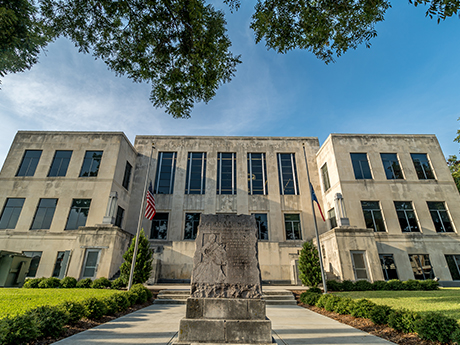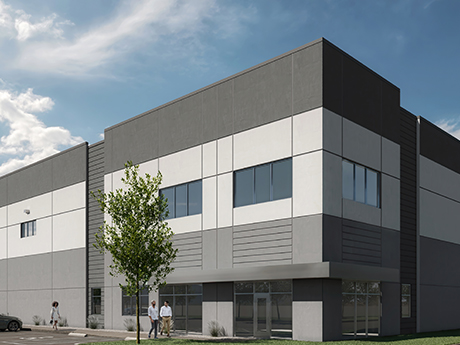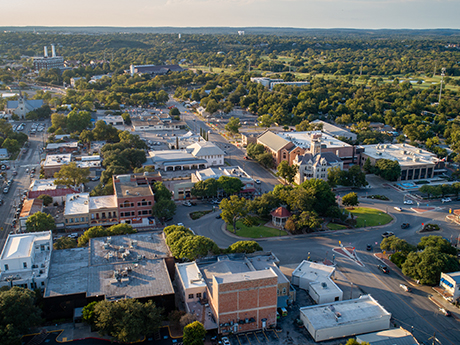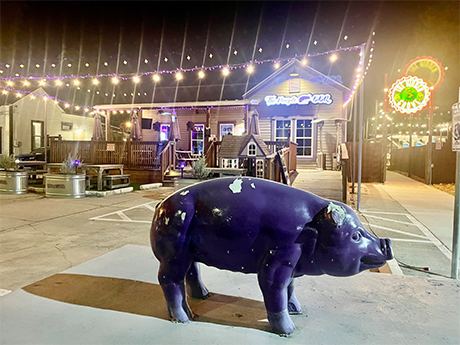By Taylor Williams
Earlier this year, data from the U.S. Census Bureau emerged stating that San Antonio had added 22,000 new residents between July 2022 and 2023, making it the nation’s fastest-growing city during that time. That figure exceeded the 18,900 new residents added between July 2021 and 2022 and brought the Alamo City’s total head count to about 1.5 million people, making it the seventh-largest U.S. city by population.
With such growth comes pressure from both the anchor city and its surrounding municipalities to deliver solid employment, housing and recreation options for residents. City officials and leaders can make good on that charge by a variety of means and mechanisms, and rarely does one city or submarket’s blueprint for accommodating growth match that of another.
As such, the suburbs surrounding the San Antonio area are increasingly standing on their own as unique communities that are more than capable of attracting quality housing development, national retail and restaurant users and new employment opportunities.
In this story, we take a closer look at specific projects and initiatives that are helping some of these municipalities effectively and efficiently ride the wave of regional growth.
Seguin: Revitalization 101
Located off I-10 on San Antonio’s eastern outskirts, Seguin has seen a 22 percent increase in its population since 2020, bringing its current estimated population to over 36,000, according to the U.S. Census Bureau.
With that influx of new people has come a pressing need for more housing, retail and restaurant space. To meet that demand, the city has taken steps to revitalize older historic buildings in the downtown area, primarily utilizing façade improvement grant programs and other economic development incentives.
“A lot of buildings in our downtown area that historically sat vacant and were under-utilized are coming back to life, and we’re seeing more diversity among the businesses in our downtown core as well,” says Josh Schneuker, Seguin’s director of economic development. “We’re targeting businesses that are going into historic buildings, many of which are older and need a lot of upkeep. We’re focused on working with those businesses to ensure we’re dedicating incentive dollars, not only to them as businesses but also to preserving the buildings that house them.”

Pictured is the Guadalupe County Courthouse in Seguin, which was recently renovated. The city has a number of rehabilitation projects of historic buildings in various stages of development as it works to attract new businesses and support existing ones.
Seguin is especially focused on bolstering its food-and-beverage scene via a mix of both local and national concepts. A couple of years ago, a married couple bought a historic single-family home in the downtown area and converted the structure into a bookstore with a wine and coffee bar. The success of Pecantown Books & Brews, named for Seguin’s claim to fame as the home of the world’s largest pecan, has spurred more interest and leasing activity among similar types of users, such as breweries, coffee shops and ice cream parlors.
Schneuker cites another restaurant, Texas barbeque eatery Burnt Bean Co., as perhaps even more instrumental in driving the growth and diversification of the city’s food-and-beverage scene. Soon after opening in 2021, Burnt Bean achieved the No. 4 ranking in Texas Monthly’s coveted list of Top 50 barbeque restaurants in the state. The significance of this accolade is difficult to overstate, Schneuker says.
“That list is like the Bible of barbeque, so that’s a big deal that’s helped put Seguin on the map, attracting visitors from not just outside the city but from across Texas and even other parts of the country,” he says. “After finishing their meal at Burnt Bean, patrons often visit a nearby brewery, boutique shop or ice cream parlor within close proximity in downtown Seguin. So that one restaurant has had a spinoff effect, not only putting Seguin on people’s radars but also giving a significant boost to small businesses in the downtown area.”
The city will also soon announce one of its largest new brick-and-mortar retail development projects in over 30 years. The nearly 140,000-square-foot development will diversify the retail options in Seguin and feature multiple national retailers. Economic development officials believe this project will serve as a catalyst for further retail growth in the city, which is actively engaging with other retail users and developers to explore additional opportunities in the area.
Lastly, the city is seeking to partner with a qualified developer or development team to redevelop The Nolte, a city-owned property in the heart of Seguin. Located directly off Central Park in the historic downtown square, The Nolte is a collection of historically significant buildings added over time.
The site offers prime opportunities for expanding housing, hospitality and commercial uses. The city purchased the property from Wells Fargo in January 2024 in conjunction with the bank’s plan to downsize to a new location. City officials have subsequently worked with a consultant to identify the highest and best use for the site.
“This is a bold and ambitious project, but we believe the timing is ideal for the city to pursue this vision in partnership with a qualified developer,” says Schneuker. “Seguin is experiencing strong momentum, with exponential population growth, substantial investments from new and existing businesses and the beginnings of a retail and commercial boom. Our hope is to partner with a developer that can bring these plans to life, making downtown Seguin a vibrant destination for both residents and visitors.”
On the employment front, Seguin retains its close connection to San Antonio via its healthy base of manufacturers. According to Schneuker, about 8,000 people in Seguin — one out of every three employed individuals — work for manufacturers and command an average annual salary of about $70,000.
Caterpillar Inc. (NYSE: CAT) is one of the largest such employers in the region. Earlier this year, the Irving-based manufacturer of construction and mining equipment announced that it was investing $90 million in its facilities in Seguin and nearby Schertz for its rollout of a new industrial engine model. Production is slated to begin in 2026.
Other manufacturers have taken note of Caterpillar’s commitment to — and confidence in — the region.
“Manufacturers such as Caterpillar and Commercial Metals employ hundreds of people in their Seguin facilities, and those jobs are being complemented by new companies entering the area,” says Schneuker. “Among them is Premium Waters, a water bottle manufacturer that will begin production here by the end of the year. We also have Maruichi, a Japanese company that will soon open a new manufacturing facility to support the semiconductor industry.”
Maruichi’s facility spans 125,000 square feet and sits on a 33-acre site within Rio Nogales Industrial Park. Production of the stainless steel pipes and tubes for the semiconductor industry — among others — is expected to drive the creation of more than 100 jobs and $75 million in capital investment throughout the region.
Schertz: Industrial Hotspot
According to its May announcement, Caterpillar’s $90 million investment in its regional facilities comprises $20 million for assembly purposes in Seguin and $70 million for component manufacturing purposes in Schertz, a northeastern suburb of about 44,000 people. The city provided Caterpillar with incentives in exchange for new job creation and other forms of capital investment; the ripple effects of that move — and many like it — are starting to crystallize.
“We’ve had warehouse and distribution developers look at our market for speculative projects,” says Scott Wayman, the city’s executive director of economic development director, with regard to the fallout of Caterpillar’s expansion. “We’re also in the process of announcing a new cold storage and distribution project for a major retailer that’s been providing food and paper goods for a major chain restaurant for 30 years.”
One such private group that is firmly established in Schertz is Titan Development, an industrial owner with offices in Austin and Albuquerque, New Mexico. Earlier this year, the company broke ground on a 196,519-square-foot industrial project that represents the first building within a larger development known as Schertz35 Business Park.

Earlier this year, Titan Development broke ground on Building 1 of Schertz35 Business Park, an industrial project that will add 196,519 square feet of space to the local supply. The regional developer, which has had a presence in Schertz for a number of years now, expects to complete the project late this year or early next year.
On the leasing front, multiple large deals have been inked over the last 18 or so months, a validation of Wayman’s portrayal of the growth potential for speculative industrial development in Schertz. These users include Bob Mills Furniture (114,396 square feet), MEI Rigging & Crating (78,362-square-foot expansion to a total of 191,297 square feet) and Quality Custom Distribution Services (116,176 square feet).
But as critical as the manufacturing base is to the Schertz economy, local leaders are focused on much more than industrial development and leasing activity. In the downtown area, numerous programs and projects are underway to revamp older buildings, improve public infrastructure and attract new retail and restaurant concepts.
According to Brian James, deputy city manager and executive director of development, these initiatives were born of natural causes.
“As the city grew and developed closer to I-35, a lot of the commercial base moved in that direction, and residents started headed that way for services, shopping, dining and medical care,” James explains. “So our Main Street, which traditionally had a mix of businesses, started to decline a bit. With the growth we’ve had in recent years, we want to have that heart, that central part of the city that feels like a community.”
But initial revitalization efforts were complicated by the fact that many downtown buildings were located within the 100-year floodplain from Cibolo Creek. Knowing this could discourage both development of new properties and investment in existing ones that would otherwise be prime candidates for rehabilitation, the city moved quickly to address the issue.
“We began by looking at providing incentives to offset additional costs of being in the floodplain, including a historic-based grant program and a general grant program for businesses,” says James. “Standard stuff — 50/50 matching grants — and we’ll go up to $40,000 per existing building over a five-year window, with a higher threshold for new builds. We put those programs in place and monitored and revised them, and they’re still fairly active today.”
Infrastructure is an especially important prerogative for Schertz, in both public and private capacities. The city works with private owners of older commercial buildings to upgrade or replace various utility lines and systems and has also revised building codes and regulations to allow reduced parking, modified landscaping and screening requirements.
With regard to public infrastructure, James says that supporting and subsidizing key improvements elevates the profile of Main Street among commuters.
“We get a lot of traffic from FM 78, but people don’t always know from their commutes that we have this Main Street and what’s there,” he says. “We’ll do things like redo curbing, widen sidewalks, make them ADA compatible and add street lighting, furniture and entry monuments.”
“The point of monumentation is to fit to the scale of the area but also to catch the attention of those people commuting on FM 78,” he continues. “We have planned ornamental lighting, streets and utilities redone, bump-outs at intersections, framed-up, on-street parking — all of which creates a physical appearance of infrastructure that everybody wants and that works.”
Lastly, the city is looking to enhance its walkability — an endeavor hindered by the fact that Schertz is not the seat of Bexar County and therefore lacks the traditional county courthouse plaza/town square at its nucleus. James says that the city has a certain area in mind to function as the hub of this broader initiative.
“We have an area that’s close enough to sort of be the center of Main Street, that’s also big enough to have events, that we’re going to make green and beautify,” he says. “And on the west end of Main Street toward Cibolo Creek, we’ve got several large parks, so we have facilities that draw people.”
“Part of the plan will include art and sculptures, activating that space for people to view and elevating the aesthetics of the creek,” he continues. “Further, our neighboring community has a trail system that runs through there that will link with that of Schertz.”
New Braunfels: Established
Unlike some other municipalities featured in this story, New Braunfels is a relatively mature market in terms of its downtown area, which makes sense given that the city’s population now exceeds 100,000 people.
According to Jeff Jewell, the city’s director of economic and community development, the downtown transformation movement started around 2006 and accelerated over the ensuing decade, yielding a four-block core that today has virtually zero retail or restaurant vacancies. But that doesn’t mean the city is resting on its laurels.
“Downtown New Braunfels is the central heartbeat of the community, but at the end of the day, we don’t think of it as in need of revitalization since it’s already doing very well,” he says. “We have very low vacancy and climbing rents, but because there’s a lot of activity down there on a regular basis, we’re always looking for ways to strengthen it.”
The low vacancy rate is even more impressive considering that since 2010, New Braunfels has seen its supply of brick-and-mortar retail space grow by about 2.5 percent annually year over year. While many retail owners and users spent much of that time looking for ways to downsize their physical footprints and develop their e-commerce platforms, New Braunfels welcomed the new inventory, knowing it would be absorbed.

Despite overall growth in the city’s supply of brick-and-mortar retail and restaurant space over the past decade, the downtown area of New Braunfels has very little vacancy. The community is now focused on adding much-needed housing stock, though local leaders continue to look for ways to improve downtown infrastructure and support local businesses.
According to Jewell, retail rents today are about $25 per square foot on average — very much on par with the national average — and new users are still showing interest. For example, Dallas-based Topgolf committed to building an $18 million facility in New Braunfels last year, and the entertainment venue could open as soon as mid-2025.
With the city’s location on I-35 and demographic trends working their magic on retail developers and tenants on the national level, city leaders remain highly focused on further strengthening established areas at the local level. Much of this work centers on infrastructural improvements.
“Broadly, we’ve used some approaches that have proven to be key to making downtowns work and are adopted from other Main Street programs,” Jewell explains. “We focus on creating an inviting, people-centric atmosphere and making sure places are accessible. We work on building capacity, not only within our organizations but with our partner organizations that care about downtown, such as the merchants’ association.”
“Our TIRZ [tax increment reinvestment zone] is really focused on parking improvements, economic development incentives and public infrastructural improvements,” he continues. “We have multiple capital improvement projects in some sort of preliminary or design stage for drainage, accessibility, sidewalks and general pedestrian-friendliness.”
Engagement with and promotion of local businesses and their owners is another big priority for Jewell and his team.
“Collaborating with those groups to make them successful and leveraging our partnerships with nonprofits and the private sector to build on the existing strengths of the downtown area — that’s all a big part of our work,” he says. “We’re very focused on engaging across that spectrum, promoting collaboration with downtown associations, encouraging people to buy local and communicating unique things about the area through promotional events.”
Jewell says that property owners in New Braunfels share the city’s concern for preserving charm and character. As a result, the downtown area retains a core group of historic buildings that haven’t been redeveloped or repurposed.
However, there has been at least one such redevelopment that has been a boon for the area: the 2018 demolition of a former horse stable that eventually became the site of craft beer and burger restaurant Muck & Fuss. The success of the concept, which features an iconic patio that offers a nod to the site’s livestock-laden history, recently prompted its owner to launch a new location in San Antonio proper.
On the housing front, Jewell acknowledges that the city’s affordability is not what it was 10 years ago, and as such, “all housing options are on the table.” But more specifically, New Braunfels’ leaders are prioritizing small-scale multifamily projects — call it 50 units on average — that are mostly backed by local
developers.
“Ten years ago, the housing price-to-income multiple was a little over 2.5; now it’s over 4,” Jewell notes. “Housing prices have definitely outpaced income levels here, but we’re making significant strides and going through a land development ordinance that will hopefully be done this year.”
“The ordinance will actually expand the availability of housing, clear the way for different types of housing to be developed and make it easier to do infill and small-scale multifamily development,” he continues. “Historically, the only options in New Braunfels were either single-family or large-scale multifamily, so we’re trying to fill in that ‘missing middle.’”
Converse: Building A Hub
Since assuming command of the Converse economic development department a couple years ago, Elan Vallender has been engaged in dozens of small initiatives that are building blocks of a larger project: creating a core area that can function as, for lack of a better term, a downtown area.
Sandwiched between I-10 and I-35, Converse has, by Vallender’s estimation, seen its population more or less double over the past decade. But this demographic attribute has not been enough to land the city its fair share of national retail and restaurant deals — a trend that could change with the establishment of a central community hub.
“We’ve been reaching out to the community to establish a vision and understand what people want,” Vallender says of his work as executive director of economic development. “We’ve gotten a lot of resident feedback to the effect that they’re interested in — not necessarily a downtown — but an area where they can convene as a community.”
“We lack a lot of dining and entertainment options, so we’re working to establish an economic development project to get some funds toward this,” he continues. “We’re contracting with an architectural firm to do some charrettes, discuss arts and entertainment developments, get resident feedback and [commission] conceptual designs to present to the board and city council.”
Community leaders have already identified a feasible site for this central hub. Under the current vision, the area would span between 30 and 50 acres, including five acres of city-owned land. Vallender says that the city plans to utilize that acreage in a preliminary manner — to roll out some initial small-scale commercial development, gauge its success and potentially use those projects as catalysts for bigger expansion.
“We’re currently reaching out and talking to developers that have undertaken similar projects elsewhere in the area,” Vallender says of the timeline. “We’ll invite them to participate in the charrettes and give feedback in terms of whether certain development components are reasonable. Once we see that level of support from residents and the board/city council, our next step will be to push forward with feasibility studies. If that’s positive, then we push into predevelopment activities.”
The area in question would be bisected by FM 1516, a thoroughfare that is currently being worked on by the Texas Department of Transportation. Under the department’s proposal, FM 1516, which connects I-10 and I-35, would be expanded from two to four lanes. The route would eventually include left turn lanes, raised medians and sidewalk and bicycle accommodations. Lastly, drainage ditches and an underground stormwater system would be installed as part of the project.
In addition, the proposed site of Converse’s new community hub would offer a high level of walkability and connectivity via its tangential location to multiple parks. Investment in those public spaces is a forthcoming proposal for the city’s economic development department, and a preliminary step in developing the district as a whole.
“Our board just passed a resolution to invest in our parks and recreations system; we could be looking at $250,000 to $500,000,” Vallender says. “The beauty is that the city has several hundred acres of parks, and we’re connecting those with trail systems. These parks touch a lot of commercial development areas, so connectivity will be hugely beneficial. Hopefully these investments will buoy our residents’ quality of life.”
Vallender expects the completion of the state-backed roadway project to facilitate Converse’s ability to land more national retailers and restaurants outside the core area. Within the downtown district, however, he expects the shopping, dining and entertainment scene to feature a heavier proportion of regional and local tenants.
But regardless of the scale and credit of the new businesses that will hopefully be coming to town, Vallender knows that these users will be impressed by at least one aspect of Converse: its supply of experienced, qualified laborers.
“While we have a couple big manufacturers [in our region] — San Antonio Masonry, Best Block, Leviat — most of our employment is retail and service,” he explains. “We’ve got room to grow, and at some point in the near future we’ll become limited by our geographic boundaries. We’re looking to make sure that what our community serves will have the businesses and sectors of business that our residents want for their quality of life.”
This article originally appeared in the September issue of Texas Real Estate Business magazine.


